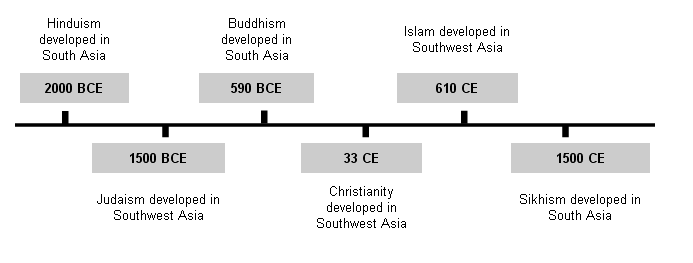
Unit 1: Redefining World Society and Culture
Lesson B: Division and Diffusion — World Belief Systems
Activity 1: Using Timelines
The major world religions and belief systems are normally divided into two categories. The first category is those "born" in South and East Asia. This category includes Hinduism, Buddhism, Sikhism, Daoism, Confucianism, and Shintoism. The second category is those "born" in Southwest Asia. Judaism, Christianity, and Islam were all born in Southwest Asia. Together these make up the majority of all religions and belief systems practiced around the world.
Before we learn more about the different religions and belief systems, let us first examine how to read a timeline. Timelines help us understand what happened when. Timelines are read left to right. Events farther to the left are the oldest. Let us examine the timeline below to make sure we know how to read it.
Development of World Religions

[1]
In the timeline above you should first notice the title. Titles help us understand what the topic of a timeline is. The title, "Development of World Religions" explains what you will learn from the timeline. This is a timeline of the "birth" of world religions.
The next thing to notice about this timeline is the dates. The earliest date is 2000 BCE and the latest date is 1500 CE. In world history, it is important to understand that different cultures have different "dates." In the Western world, a date might be the year 2011 while in Israel it is 5871.
Other areas of the world have other concepts of what a year or date is. BCE (Before Common Era) is used to indicate the number of years before the year "0." For most of the Western world, this is called BC (Before Christ) and it was meant to mark the traditional birth date of Jesus of Nazareth.
World historians refer to anything after year "0" as CE (Common Era). For most of the Western world, this is called AD (Anno Domini). In Latin, this means the year of the Lord. BC and AD worked in countries that had a history of Christianity, but they were not useful in other countries that did not measure time in Christian terms. World historians came to an agreement about how to determine years and dates so that all world historians from different countries and cultures would use the same terms to study and determine dates in history.
Now that you understand where BCE and CE come from, how do you determine how many years passed between dates? To determine how many years passed between the development of Hinduism and Judaism, you simply subtract. 2000 BCE (Hinduism) – 1500 BCE (Judaism) = 500 years. This is also easy in determining how many years passed between the development of Islam and Sikhism. In this case, you still subtract, but you take 1500 CE and subtract 610 CE to determine that 890 years passed between Islam and Sikhism.
It is also easy to determine how many years between a BCE date and a CE date – we add. Let us determine how many years between the development of Buddhism and Christianity. If the year 590 is 590 years before the year "0", then you simply take 590 BCE and add an additional 33 years (33 CE) to get 590 + 33 = 623 years.
Page Notes:
[1] Source: This image has been created using http://www.teach-nology.com/web_tools/materials/timeline/ with information from http://www.sacred-texts.com/time/origtime.htm.

